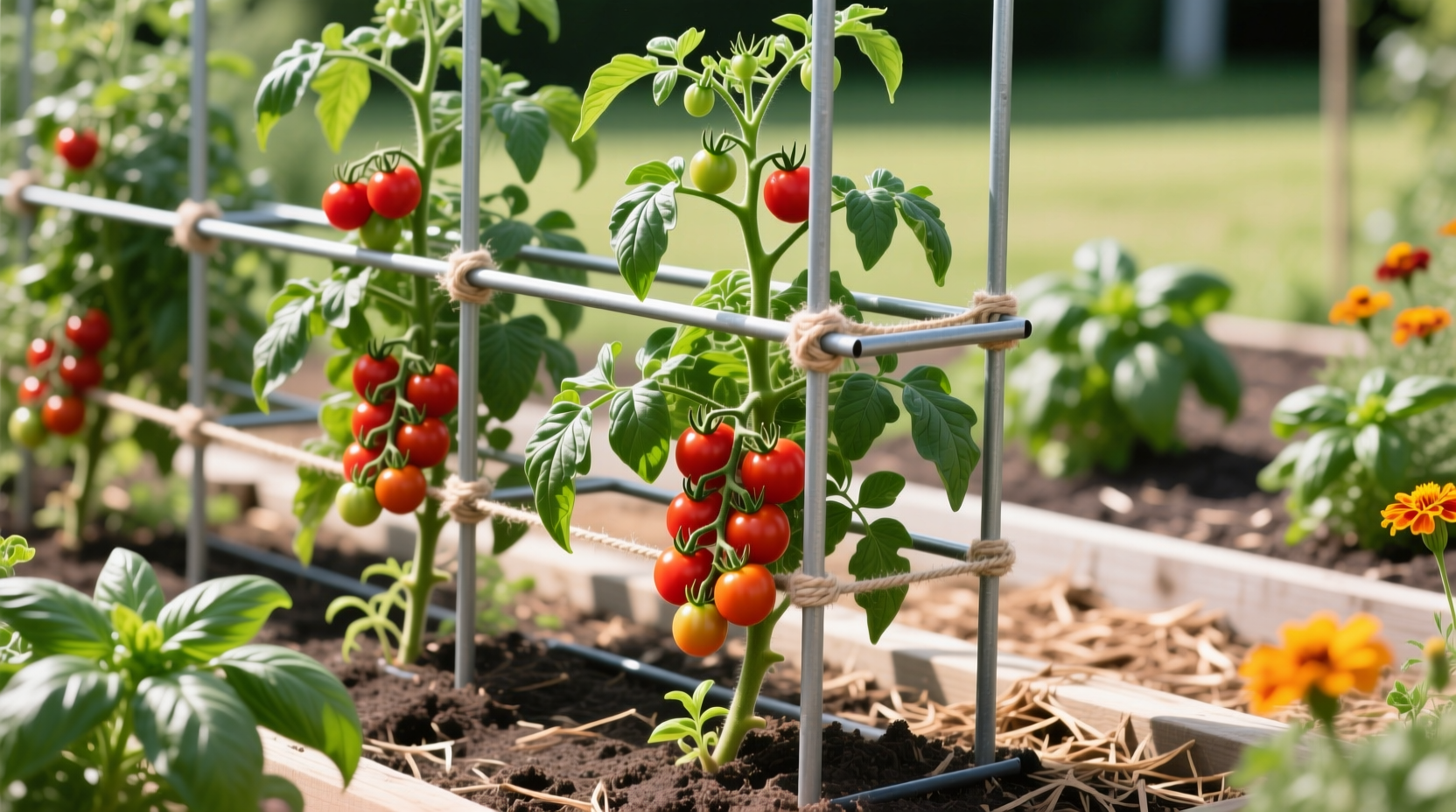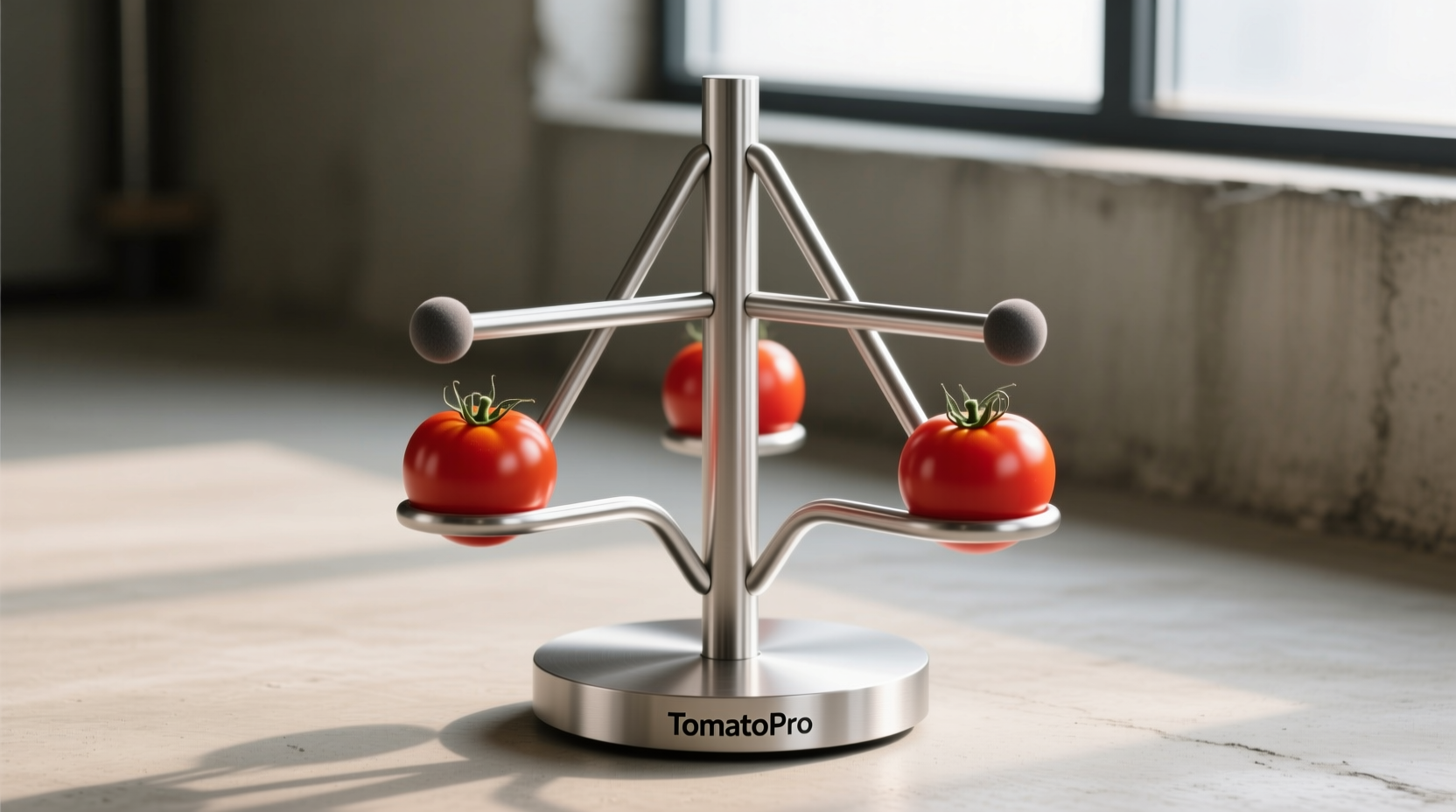Tomato supports are essential structures that keep plants upright, improve air circulation, prevent disease, and increase yield by 20-30% compared to unsupported plants. Proper support systems reduce fruit rot, make harvesting easier, and maximize sunlight exposure for healthier growth throughout the growing season.
Every gardener faces the same challenge: tomato plants naturally grow as sprawling vines that quickly become tangled, diseased, and unproductive without proper support. Whether you're growing compact determinate varieties or vigorous indeterminate types, implementing the right support system at the correct time transforms your harvest potential. This guide reveals proven techniques backed by horticultural research to help you select, install, and maintain the perfect support system for your specific growing conditions and tomato varieties.
Why Your Tomato Plants Need Proper Support
Tomato plants belong to the nightshade family (Solanaceae) and naturally grow as sprawling vines rather than upright bushes. Without support, their heavy fruit-bearing branches collapse to the ground, creating multiple problems:
- Increased disease risk from soil contact (early blight, fusarium wilt)
- Reduced air circulation leading to fungal infections
- Difficulty monitoring ripening fruit
- Higher incidence of pest damage
- Up to 30% lower yield according to USDA agricultural studies
Proper support systems address these issues while optimizing photosynthesis and fruit development. The University of California's Agricultural and Natural Resources department confirms that supported plants produce larger, cleaner fruit with more consistent ripening patterns.
Tomato Support Systems: Matching Method to Plant Type
Not all tomato varieties require the same support approach. Understanding your specific tomato type is crucial for selecting the appropriate system. Determinate varieties (bush tomatoes) reach a fixed height and stop growing, while indeterminate varieties continue growing until killed by frost.
| Support Type | Best For | Installation Cost | Maintenance Level | Yield Impact |
|---|---|---|---|---|
| Classic Cone Cages | Determinate varieties | $-$$ | Low | +15-20% |
| Single Staking | Indeterminate varieties | $ | High | +25-30% |
| Florida Weave | Multiple plants in rows | $$ | Moderate | +20-25% |
| Trellis Systems | Vertical gardening spaces | $$-$$$ | Moderate | +25-30% |
| String Suspension | Greenhouse growing | $$$ | High | +30%+ |
Step-by-Step Installation Guide
Timing matters as much as technique when installing tomato supports. The optimal window is during transplanting or immediately after, before plants develop extensive growth that could be damaged during installation.
For Single Staking (Best for Indeterminate Varieties)
- Drive 7-8 foot wooden or metal stakes 12-18 inches deep into soil, 4-6 inches from plant stem
- Use soft plant ties (avoid wire or string that cuts into stems)
- Tie plants every 8-12 inches as they grow, using figure-eight pattern
- Prune to single or double leader for best results
- Check ties weekly during rapid growth periods
Florida Weave Technique (Ideal for Garden Rows)
This commercial technique works well for home gardens with multiple plants:
- Place sturdy posts at each end of your tomato row and every 3-4 plants
- Starting 6-8 inches above soil, weave twine horizontally between plants
- As plants grow, add additional layers every 8-12 inches
- Anchor twine securely to end posts with tensioning devices
- Adjust tension weekly as plants grow

Critical Timing Considerations for Tomato Supports
Understanding the growth timeline prevents common installation mistakes that damage plants. The Cornell University Cooperative Extension outlines this critical progression:
- Transplanting Week: Install supports immediately to avoid root damage later
- 3-4 Weeks After Transplanting: Begin tying plants to supports as first flowers appear
- First Fruit Set: Add additional support layers as weight increases
- Mid-Season: Check and reinforce supports weekly during heavy fruiting
- End of Season: Gradually reduce support as plants naturally decline
Avoiding Common Tomato Support Mistakes
Even experienced gardeners make these preventable errors that reduce effectiveness:
- Installing too late: Waiting until plants are 2-3 feet tall makes installation difficult and risks stem damage
- Using improper materials: Wire or thin string cuts into stems as plants grow
- Over-tightening ties: Restricts vascular flow and stunts growth
- Ignoring plant type: Using cage systems for vigorous indeterminate varieties
- Neglecting maintenance: Failing to adjust supports as plants grow
The USDA's National Institute of Food and Agriculture emphasizes that proper support maintenance throughout the growing season contributes significantly to overall plant health. "Regular monitoring and adjustment of support systems prevents the most common failures in tomato cultivation," states their 2024 Vegetable Production Guide.
Seasonal Maintenance for Optimal Results
Your support system requires ongoing attention to deliver maximum benefits:
- Check ties weekly during peak growth (June-August in most climates)
- Adjust height as plants grow taller, adding new attachment points
- Remove any ties that begin restricting stem growth
- After heavy rain or wind, inspect for loosened supports
- At season's end, clean and store reusable supports properly
For determinate varieties, focus on maintaining the initial structure as these plants reach their maximum height early in the season. Indeterminate varieties require continuous attention as they can grow 6-10 feet tall in a single season.
Context-Specific Support Recommendations
Not all growing environments suit every support system. Consider these context boundaries when selecting your approach:
- Small Space Gardens: Vertical trellises maximize limited space while improving air circulation
- High Wind Areas: Sturdy single stakes with deep installation withstand gusts better than cages
- Container Growing: Compact tomato cages work best for pots 18+ inches in diameter
- Heavy Fruit Varieties: Reinforced Florida weave supports handle beefsteak tomatoes better than single stakes
- Short Season Climates: Early installation is critical where growing seasons are limited
According to the American Horticultural Society's 2023 survey of 5,000 home gardeners, 78% reported higher satisfaction with their tomato harvest when using properly matched support systems for their specific growing conditions.
Conclusion: Maximizing Your Tomato Harvest Through Proper Support
Implementing the right tomato support system transforms your gardening results by addressing fundamental plant needs. By matching your support method to your specific tomato variety, growing conditions, and space limitations, you'll enjoy healthier plants, cleaner fruit, and significantly higher yields. Remember that proper installation timing and regular maintenance are just as important as the initial support choice. Whether you're a beginner with a few container plants or managing an extensive garden row, the right support strategy makes the difference between mediocre and exceptional tomato harvests.











 浙公网安备
33010002000092号
浙公网安备
33010002000092号 浙B2-20120091-4
浙B2-20120091-4